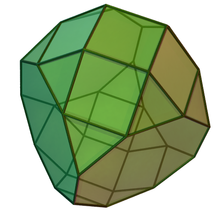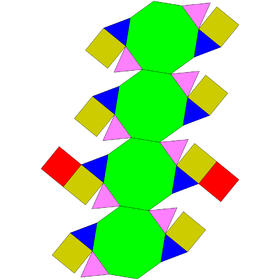
In geometry, a Johnson solid is a strictly convex polyhedron each face of which is a regular polygon. There is no requirement that each face must be the same polygon, or that the same polygons join around each vertex. An example of a Johnson solid is the square-based pyramid with equilateral sides ; it has 1 square face and 4 triangular faces. Some authors require that the solid not be uniform before they refer to it as a “Johnson solid”.
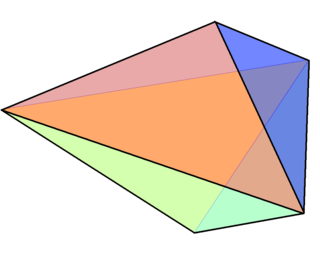
In geometry, the triangular bipyramid is a type of hexahedron, being the first in the infinite set of face-transitive bipyramids. It is the dual of the triangular prism with 6 isosceles triangle faces.
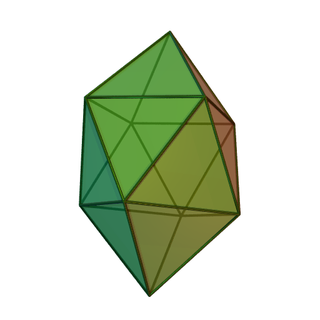
In geometry, the gyroelongated square bipyramid, heccaidecadeltahedron, or tetrakis square antiprism is one of the Johnson solids. As the name suggests, it can be constructed by gyroelongating an octahedron by inserting a square antiprism between its congruent halves. It is one of the eight strictly-convex deltahedra.

In geometry, the triaugmented triangular prism, tetracaidecadeltahedron, or tetrakis triangular prism is one of the Johnson solids. Each of its 14 faces is an equilateral triangle, making it a deltahedron. As the name suggests, it can be constructed by attaching equilateral square pyramids to each of the three square faces of the triangular prism.
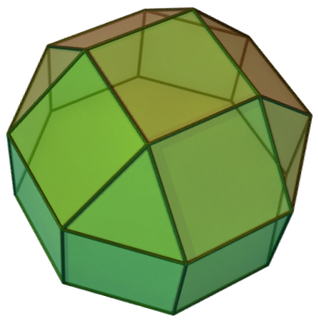
In geometry, the elongated square cupola is one of the Johnson solids. As the name suggests, it can be constructed by elongating a square cupola by attaching an octagonal prism to its base. The solid can be seen as a rhombicuboctahedron with its "lid" removed.

In geometry, the square orthobicupola is one of the Johnson solids. As the name suggests, it can be constructed by joining two square cupolae along their octagonal bases, matching like faces. A 45-degree rotation of one cupola before the joining yields a square gyrobicupola.

In geometry, the square gyrobicupola is one of the Johnson solids. Like the square orthobicupola, it can be obtained by joining two square cupolae along their bases. The difference is that in this solid, the two halves are rotated 45 degrees with respect to one another.
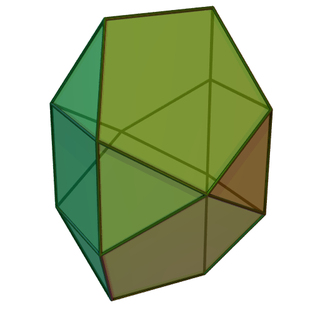
In geometry, the bilunabirotunda is one of the Johnson solids. A Johnson solid is one of 92 strictly convex polyhedra that is composed of regular polygon faces but are not uniform polyhedra. They were named by Norman Johnson, who first listed these polyhedra in 1966.

In geometry, the elongated square bipyramid is one of the Johnson solids. As the name suggests, it can be constructed by elongating an octahedron by inserting a cube between its congruent halves.

In geometry, the gyrobifastigium is the 26th Johnson solid. It can be constructed by joining two face-regular triangular prisms along corresponding square faces, giving a quarter-turn to one prism. It is the only Johnson solid that can tile three-dimensional space.
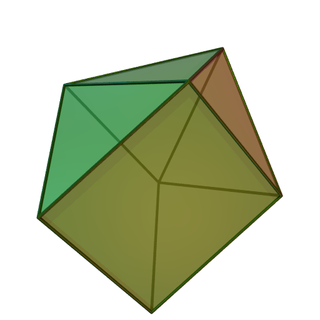
In geometry, the augmented triangular prism is one of the Johnson solids. As the name suggests, it can be constructed by augmenting a triangular prism by attaching a square pyramid to one of its equatorial faces. The resulting solid bears a superficial resemblance to the gyrobifastigium, the difference being that the latter is constructed by attaching a second triangular prism, rather than a square pyramid.

In geometry, the biaugmented triangular prism is one of the Johnson solids. As the name suggests, it can be constructed by augmenting a triangular prism by attaching square pyramids to two of its equatorial faces.

In geometry, the biaugmented pentagonal prism is one of the Johnson solids. As the name suggests, it can be constructed by doubly augmenting a pentagonal prism by attaching square pyramids to two of its nonadjacent equatorial faces.

In geometry, the elongated triangular orthobicupola or cantellated triangular prism is one of the Johnson solids. As the name suggests, it can be constructed by elongating a triangular orthobicupola by inserting a hexagonal prism between its two halves. The resulting solid is superficially similar to the rhombicuboctahedron, with the difference that it has threefold rotational symmetry about its axis instead of fourfold symmetry.

In geometry, the augmented truncated tetrahedron is one of the Johnson solids. It is created by attaching a triangular cupola to one hexagonal face of a truncated tetrahedron.

In geometry, the augmented truncated cube is one of the Johnson solids. As its name suggests, it is created by attaching a square cupola onto one octagonal face of a truncated cube.
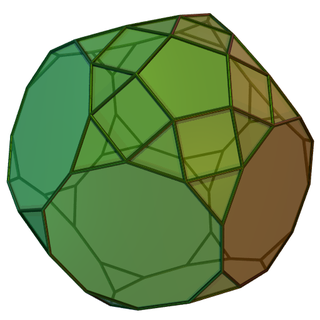
In geometry, the augmented truncated dodecahedron is one of the Johnson solids. As its name suggests, it is created by attaching a pentagonal cupola onto one decagonal face of a truncated dodecahedron.

In geometry, the parabiaugmented truncated dodecahedron is one of the Johnson solids. As its name suggests, it is created by attaching two pentagonal cupolas onto two parallel decagonal faces of a truncated dodecahedron.
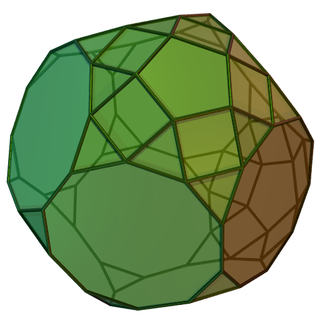
In geometry, the metabiaugmented truncated dodecahedron is one of the Johnson solids. As its name suggests, it is created by attaching two pentagonal cupolas onto two nonadjacent, nonparallel decagonal faces of a truncated dodecahedron.
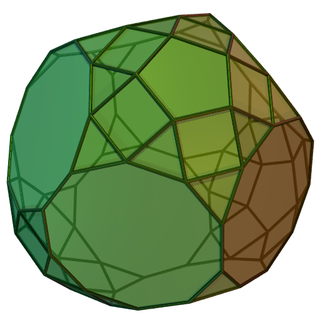
In geometry, the triaugmented truncated dodecahedron is one of the Johnson solids ; of them, it has the greatest volume in proportion to the cube of the side length. As its name suggests, it is created by attaching three pentagonal cupolas onto three nonadjacent decagonal faces of a truncated dodecahedron.
